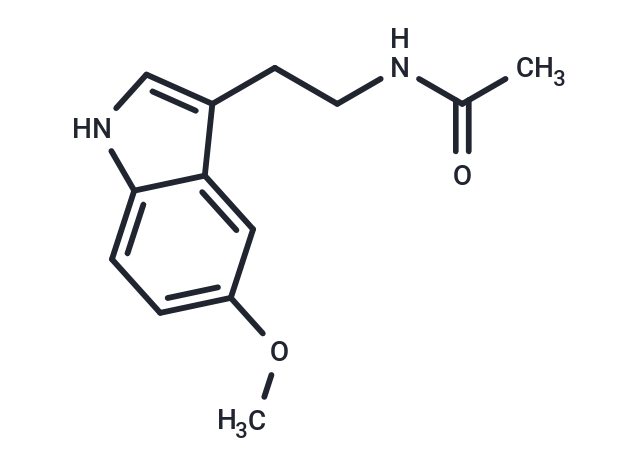Shopping Cart
- Remove All
 Your shopping cart is currently empty
Your shopping cart is currently empty

Melatonin (Melatonine) is a natural hormone secreted by the pineal gland that activates melatonin receptors. Melatonin is a hormone that regulates the biological clock and also has antioxidant and anti-inflammatory activities.

| Pack Size | Price | Availability | Quantity |
|---|---|---|---|
| 1 g | 29 € | In Stock | |
| 5 g | 60 € | In Stock | |
| 1 mL x 10 mM (in DMSO) | 27 € | In Stock |
| Description | Melatonin (Melatonine) is a natural hormone secreted by the pineal gland that activates melatonin receptors. Melatonin is a hormone that regulates the biological clock and also has antioxidant and anti-inflammatory activities. |
| In vitro | METHODS: Ten cells were pretreated with EIPA (50 µM) for 1.5 h. Dextran index was measured by Dextran uptake assay. RESULTS: Immortalized but untransformed hTERT-HME1 mammary epithelial cells and MCF10A cells did not exhibit megaloblast efflux in complete medium but stimulated dextran uptake by nutrient deprivation. Although PIK3CB was found to be required for growth factor-stimulated macrocytosis, oncogenic mutations in PIK3CA were sufficient to induce constitutive macrocytosis in mouse embryonic fibroblast MEFs and untransformed MCF10A cells. [1] METHODS: MKN28 cells were treated with EIPA (5-100 µM) for 48 h. Cell proliferation was detected by cell count. RESULTS: Cell exposure to EIPA inhibited the proliferation of MKN28 cells in a dose- and time-dependent manner. [2] |
| In vivo | METHODS: To assay in vivo activity, EIPA (10 mg/kg) was injected intraperitoneally into BALB/c mice bearing 4T1 xenografts, and 70 kD FITC-Ficoll was injected into the tumors 1 h later. The mice were necropsied 1 h after Ficoll injection, and the tumors were excised and frozen in OCT. RESULTS: EIPA-sensitive 70 kD FITC-Ficoll uptake was observed in in situ homozygous 4T1 tumors of BALB/c mice, suggesting that AMPK activation or other signals are sufficient to trigger the formation of large fusions in vivo. [1] |
| Alias | N-Acetyl-5-methoxytryptamine, Melatonine |
| Molecular Weight | 232.28 |
| Formula | C13H16N2O2 |
| Cas No. | 73-31-4 |
| Smiles | COC1=CC=C2NC=C(CCNC(C)=O)C2=C1 |
| Relative Density. | 1.175g/cm3 |
| Storage | store at low temperature,keep away from direct sunlight,store under nitrogen | Powder: -20°C for 3 years | In solvent: -80°C for 1 year | Shipping with blue ice. | |||||||||||||||||||||||||||||||||||
| Solubility Information | DMSO: 55 mg/mL (236.78 mM), Sonication is recommended. | |||||||||||||||||||||||||||||||||||
| In Vivo Formulation | 10% DMSO+90% Saline: 1.16 mg/mL (4.99 mM), Solution. Please add the solvents sequentially, clarifying the solution as much as possible before adding the next one. Dissolve by heating and/or sonication if necessary. Working solution is recommended to be prepared and used immediately. The formulation provided above is for reference purposes only. In vivo formulations may vary and should be modified based on specific experimental conditions. | |||||||||||||||||||||||||||||||||||
Solution Preparation Table | ||||||||||||||||||||||||||||||||||||
DMSO
| ||||||||||||||||||||||||||||||||||||

Copyright © 2015-2025 TargetMol Chemicals Inc. All Rights Reserved.